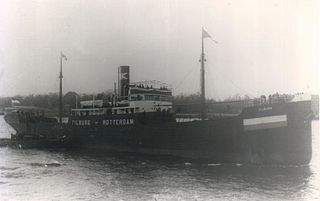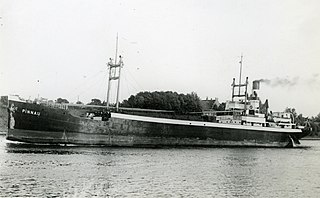Jamnagar was a 576 GRT coaster which was built in 1924 for Maharaja Jam Sahib of Nawanagar. In 1941 she entered service with the Royal Indian Navy. In 1944, she was sold into merchant service before being requisitioned by the Ministry of War Transport (MoWT) and renamed Empire Bulbul. In 1947, she was sold into merchant service and renamed Hellenic Bulbul. The name Hellenic Bee had been allocated but she ran aground and sank before the proposed name change could be implemented.
Stettin was a 2,646 GRT cargo ship which was built in 1923 for the Stettiner Dampfer Compagnie. In 1930 she was sold to Norddeutscher Lloyd and renamed Akka. She was requisitioned by the Kriegsmarine in 1940. Akka was seized as a war prize in 1945, passing to the Ministry of War Transport (MoWT) and being renamed Empire Calder.
Ceuta was a 2,719 GRT cargo ship which was built in 1929 for the Oldenburg-Portugiesische Dampfschiffs-Reederei. She was sunk during an air raid in 1943, but later raised, repaired and returned to service. She was seized as a war prize in 1945, passed to the British Ministry of War Transport (MoWT) and renamed Empire Camel.
Cap Tafelneh was a 2,266 GRT cargo ship which was built in 1920 by Burntisland Shipbuilding Company Ltd, Fife, Scotland. She was built for Joseph Lasry as Sydney Lasry. In 1931, she was sold to Compagnie Générale Transatlantique and renamed Ariège. In 1938 she was sold to Société Anonyme de Gerance D'Armement and renamed Cap Tafelneh. She was bombed and sunk at Dunkirk in 1940.
Badenia was a 921 GRT coaster that was built in 1912 by F Schichau GmbH, Elbing for German owners. She was renamed Titania in 1939. She was seized by the Allies at Rendsburg in May 1945, passed to the Ministry of War Transport (MoWT) and renamed Empire Conexe. In 1947, she was sold into merchant service and renamed Ringdove, serving until 1950 when she was scrapped.
Elbe was a 1,197 GRT cargo ship that was built in 1921 by Nobiskrug Werft, Rendsburg for German owners. She was seized by the Allies at Copenhagen, Denmark in May 1945, passed to the Ministry of War Transport (MoWT) and renamed Empire Confederation. In 1946, she was transferred to the Soviet Union and renamed José Dias. She served until she was scrapped in 1966.
Orlanda was a cargo ship that was built in 1920 by F Krupp AG, Emden for German owners. She was seized by the Allies in Hamburg, in May 1945, passed to the Ministry of War Transport (MoWT) and renamed Empire Conington. In 1946, she was allocated to the Newfoundland Government. In 1949, she was sold to Panama and renamed Alabe. She served until 1958, when she was scrapped.
Ambria was a cargo ship that was built in 1922 by Deutsche Werft, Finkenwerder for German owners. She was sold in 1934 and renamed Gumbinnen. She was sunk by a British destroyer in 1941, raised and repaired. Gumbinnen was seized by the Allies in Flensburg, in May 1945, passed to the Ministry of War Transport (MoWT) and renamed Empire Conleith. In 1946, she was allocated to the Norwegian Government and renamed Dragnes. She was sold into Norwegian merchant service and renamed Mimona. In 1959, she was sold and renamed Malay. She served until 1961 when she was scrapped.
Mies was a 242 GRT tug that was built as Empire Connie in 1945 by A Hall & Co Ltd, Aberdeen for the Ministry of War Transport (MoWT). In 1946, she was sold to the Royal Netherlands Navy and renamed Mies. In 1947, she was sold to the Government of the Dutch East Indies, passing to the Indonesian Government in 1951 and then the Indonesian Navy in 1953. In 1978, she was sold and renamed Taluk Ambon, serving until 1983 when she was deleted from shipping registers.

Ljusneälf was a 1,391 GRT cargo ship that was built in 1917 as Tilburg by L Smit & Zoon, Kinderdijk for Dutch owners. She was sold to German owners in 1922 and renamed Ljusneälf. A sale in 1938 saw her renamed Hubert Schröder. She was seized by the Allies in April 1945, passed to the Ministry of War Transport (MoWT) and renamed Empire Conquest.
Ganter was a 1,771 GRT cargo ship that was built in 1927 by G Seebeck AG, Bremerhaven, Germany for German owners. She was requisitioned by the Kriegsmarine during the Second World War and operated as Transporter RO 29, she was seized by the Allies in May 1945. She was passed to the Ministry of War Transport (MoWT) and was renamed Empire Consistance, being sold into merchant service in 1948. In 1950, she was sold to the Dutch government and renamed Jan Willem and then sold and renamed Maria in 1951. She was sold to Finnish owners later that year and being renamed Dagny. She served until she was scrapped in 1967.
Selnes was a 1,593 GRT cargo ship that was built in 1928 as Gemma by Flensburger Schiffbau-Gesellschaft, Flensburg, Germany for German owners. A sale in 1929 saw her renamed Peter Vith. She was seized by the Allies in May 1945, passed to the Ministry of War Transport (MoWT) and was renamed Empire Constitution. In 1946, she was transferred to Norway and renamed Grannes and then Selnes following a further sale later that year. In 1950, she was involved in a collision in the Thames Estuary and was declared a total loss.

Pinnau was a 1,198 GRT cargo ship that was built in 1922 by Nobiskrug Werft GmbH, Rendsburg, Germany for German owners. She was seized by the Allies in May 1945, passed to the Ministry of War Transport (MoWT) and was renamed Empire Constructor. In 1947, she was sold into merchant service and renamed Estkon. She served until 1959 when she was scrapped.

Barlind was a 1,453 GRT cargo ship that was built in 1938 as Süderau by Deutsche Schiff- und Maschinenbau AG, Bremen, Germany for German owners. She was seized by the Allies in May 1945, passed to the Ministry of War Transport (MoWT) and was renamed Empire Content. In 1946, she was allocated to Norway and renamed Svartnes. She was sold into merchant service in 1947 and renamed Barlind. In 1971, she was sold to Greece and renamed Ikaria. She served until 1972 when she was scrapped.
Alk was a 1,175 GRT cargo ship that was built in 1924 by Neptun AG, Rostock, Germany for German owners. She was seized by the Allies in May 1945, passed to the Ministry of War Transport (MoWT) and was renamed Empire Contest. In 1946, she was allocated to the Soviet Union and renamed Vereshyagin (Верещагин). She served until about 1960, being deleted from Lloyd's Register in that year.
Anakriya was a 1,000 GRT cargo ship that was built in 1925 as Riga by Travewerk Gebrüder Goedhart AG, Hamburg, Germany. After a sale in 1934 she was renamed Königsberg. In 1939, she was renamed Stettin. In 1945, she was seized by the Allies at Hamburg, passed to the Ministry of War Transport (MoWT) and was renamed Empire Conway. In 1946, she was passed to the Soviet Union, initially renamed Stettin, and then renamed Anakriya.
Kolno was a 2,487 GRT cargo ship that was built in 1936 as Nordcoke by Lübecker Flenderwerke AG, Lübeck, Germany. In 1940, she was requisitioned by the Kriegsmarine and was renamed Nordlicht. In 1945, she was seized by the Allies at Hamburg, passed to the Ministry of War Transport (MoWT) and was renamed Empire Conwear. In 1946, she was passed to the Soviet Union and renamed Armavir. In 1947, she was transferred to Poland and renamed Kolno. She served until 1971 when she ran aground off Falsterbo, Sweden, following which she served as a hulk until scrapped in 1983.
Wilhelm Russ was a 997 GRT coaster that was built in 1921 by Stettiner Oderwerke AG, Stettin, Germany. In 1945, she was seized by the Allies at Eckernförde, passed to the Ministry of War Transport (MoWT) and was renamed Empire Cony. In 1947, she was sold into merchant service and renamed Elsie Beth. In 1950, she was sold back to her original managers and renamed Wilhelm Russ. She served until 1958 when she was scrapped.
Empire Conyngham was a 1,408 GRT cargo ship that was built as Marie in 1899 by Neptun AG, Rostock, Germany for German owners. A sale in 1923 saw her renamed Norburg. She was sold to Latvia in 1925 and renamed Gauja, serving until 1941 when she was captured by the Kriegsmarine in the Baltic Sea. In 1945, she was seized by the Allies, passed to the Ministry of War Transport (MoWT) and was renamed Empire Conyngham. In 1946, she was scuttled with a cargo of obsolete bombs.
The Bernhard Blumenfeld was a 2,879 GRT cargo ship that was completed in 1921 as the SS Dalewood by Eltringham's, Ltd., Willington on Tyne, England. She was sold to a German company in 1923 and renamed the Bernhard Blumenfeld. She was sold again in 1938 and renamed the Carl Jüngst.


